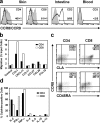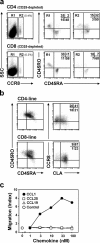A skin-selective homing mechanism for human immune surveillance T cells
- PMID: 15123746
- PMCID: PMC2211907
- DOI: 10.1084/jem.20032177
A skin-selective homing mechanism for human immune surveillance T cells
Abstract
Effective immune surveillance is essential for maintaining protection and homeostasis of peripheral tissues. However, mechanisms controlling memory T cell migration to peripheral tissues such as the skin are poorly understood. Here, we show that the majority of human T cells in healthy skin express the chemokine receptor CCR8 and respond to its selective ligand I-309/CCL1. These CCR8(+) T cells are absent in small intestine and colon tissue, and are extremely rare in peripheral blood, suggesting healthy skin as their physiological target site. Cutaneous CCR8(+) T cells are preactivated and secrete proinflammatory cytokines such as tumor necrosis factor-alpha and interferon-gamma, but lack markers of cytolytic T cells. Secretion of interleukin (IL)-4, IL-10, and transforming growth factor-beta was low to undetectable, arguing against a strict association of CCR8 expression with either T helper cell 2 or regulatory T cell subsets. Potential precursors of skin surveillance T cells in peripheral blood may correspond to the minor subset of CCR8(+)CD25(-) T cells. Importantly, CCL1 is constitutively expressed at strategic cutaneous locations, including dermal microvessels and epidermal antigen-presenting cells. For the first time, these findings define a chemokine system for homeostatic T cell traffic in normal human skin.
Figures






Similar articles
-
Skin-homing CLA+ T cells and regulatory CD25+ T cells represent major subsets of human peripheral blood memory T cells migrating in response to CCL1/I-309.Eur J Immunol. 2002 Dec;32(12):3506-14. doi: 10.1002/1521-4141(200212)32:12<3506::AID-IMMU3506>3.0.CO;2-#. Eur J Immunol. 2002. PMID: 12442333
-
Skin-versus gut-skewed homing receptor expression and intrinsic CCR4 expression on human peripheral blood CD4+CD25+ suppressor T cells.Eur J Immunol. 2003 Jun;33(6):1488-96. doi: 10.1002/eji.200323658. Eur J Immunol. 2003. PMID: 12778466
-
Control of lymphocyte recirculation in man. II. Differential regulation of the cutaneous lymphocyte-associated antigen, a tissue-selective homing receptor for skin-homing T cells.J Immunol. 1993 Feb 1;150(3):1122-36. J Immunol. 1993. PMID: 7678617
-
Chemokine-mediated control of T cell traffic in lymphoid and peripheral tissues.Mol Immunol. 2005 May;42(7):799-809. doi: 10.1016/j.molimm.2004.06.040. Epub 2004 Nov 23. Mol Immunol. 2005. PMID: 15829268 Review.
-
Mechanisms of T-cell homing to skin.Adv Dermatol. 2001;17:211-41. Adv Dermatol. 2001. PMID: 11758117 Review.
Cited by
-
A Task Force Against Local Inflammation and Cancer: Lymphocyte Trafficking to and Within the Skin.Front Immunol. 2018 Oct 24;9:2454. doi: 10.3389/fimmu.2018.02454. eCollection 2018. Front Immunol. 2018. PMID: 30405637 Free PMC article. Review.
-
Skin-Resident Effector Memory CD8+CD28- T Cells Exhibit a Profibrotic Phenotype in Patients with Systemic Sclerosis.J Invest Dermatol. 2017 May;137(5):1042-1050. doi: 10.1016/j.jid.2016.11.037. Epub 2016 Dec 22. J Invest Dermatol. 2017. PMID: 28012718 Free PMC article.
-
Genetic control of the inflammatory T-cell response in regulatory T-cell deficient scurfy mice.Clin Immunol. 2010 Aug;136(2):162-9. doi: 10.1016/j.clim.2010.04.004. Epub 2010 May 8. Clin Immunol. 2010. PMID: 20452830 Free PMC article. Review.
-
The SKINT1-like gene is inactivated in hominoids but not in all primate species: implications for the origin of dendritic epidermal T cells.PLoS One. 2015 Apr 1;10(4):e0123258. doi: 10.1371/journal.pone.0123258. eCollection 2015. PLoS One. 2015. PMID: 25830554 Free PMC article.
-
Immune phenotypes that are associated with subsequent COVID-19 severity inferred from post-recovery samples.Nat Commun. 2022 Nov 25;13(1):7255. doi: 10.1038/s41467-022-34638-2. Nat Commun. 2022. PMID: 36433939 Free PMC article.
References
-
- Von Andrian, U.H., and C.R. Mackay. 2000. T-cell function and migration. Two sides of the same coin. N. Engl. J. Med. 343:1020–1034. - PubMed
-
- Moser, B., and P. Loetscher. 2001. Lymphocyte traffic control by chemokines. Nat. Immunol. 2:123–128. - PubMed
-
- Kunkel, E.J., and E.C. Butcher. 2002. Chemokines and the tissue-specific migration of lymphocytes. Immunity. 16:1–4. - PubMed
-
- Dewald, B., M. Thelen, and M. Baggiolini. 1988. Two transduction sequences are necessary for neutrophil activation by receptor agonists. J. Biol. Chem. 263:16179–16184. - PubMed
-
- Sallusto, F., D. Lenig, R. Förster, M. Lipp, and A. Lanzavecchia. 1999. Two subsets of memory T lymphocytes with distinct homing potentials and effector functions. Nature. 401:708–712. - PubMed

